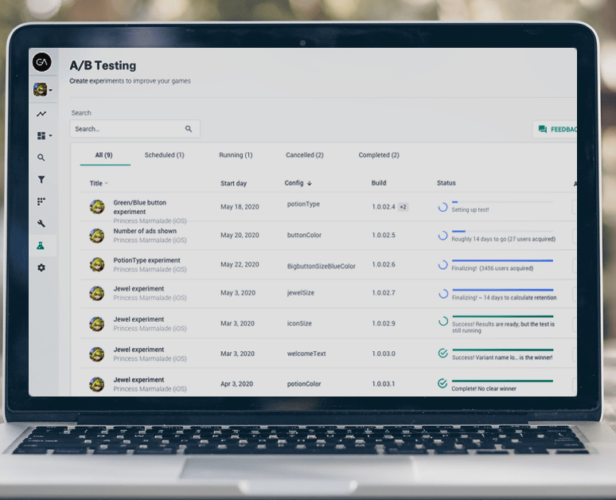Resources > All
Insights and tips about the games industry
Subscribe for gaming insights, industry reports and product updates delivered straight to your inbox.
#ASO
7 ways to optimize your mobile game on the app stores
“One does not simply hit the top of the app stores” – Boromir, Lord of ASO. Seriously though. Getting your game noticed on the app stores is no easy feat. Just like websites have SEO (search engine optimization), app stores have ASO (app store optimization). So I thought it best to ask some of the industry experts. I took the time to talk to a bunch of different developers, some with games on the Google Play store, others with games on the Apple store. And some with games on both. Simply to see how they set up their game’s pages, what they felt was most important, and to discover their top tips when it comes to the Mobile Store Page. I’ve compiled them into a bunch of takeaways, but I’ve kept all of the quotes in so you can see...
#Ads & Monetization
A Game Developers’ Guide to Playable Ads
Playable ads have become more and more popular in the last couple of years. According to eMarketer, 28% of ad agency professionals in the US think playable ads are the most effective format out there. So what makes a great playable? And what steps should you take when making your own? We look at that, and more, in this blog. But before we dig in, let’s go over the basics. Playable ads – the basics Playable ads are exactly what they sound like – adverts you can play. Similar to free demos, they let you try out an app or game before you commit to downloading it, rather than just watching a video or looking at an image. What makes a great playable ad Playable ads are generally only a minute or so long. And if you’ve done any research...
#Marketing & Publishing
5 copywriting hacks to ace your mobile game’s push notifications
Editor’s note: This article was originally published by Adjust. You can read the original version here. Since the average mobile app loses 73% of new users within 48 hours of the initial download, customer retention is the real growth driver for mobile apps. Push notifications are an essential part of the user retention puzzle. These updates, reminders, and special offers are like little hooks that pull users back into your app. Push notifications increase the 90-day retention rate by 23% compared to users who deactivate them. Push notifications are a useful tool for: Improving brand awareness and engagement Converting inactive users to habitual users Improving the user experience Advertising products and special offers …but only if you use them properly. Writing useful push notifications is a real challenge. You need to be creative enough to stand out from the dozens...
#Data & Analytics
4 features to look out for when picking a consent management tool
Editor’s note: This article was written by Nandi Gurprasad, head of Strategic Partnerships at Ogury. As GDPR and Privacy is usually a tricky topic, we’ve asked them to dive into one of their recommended solutions: Ogury Choice Manager. GDPR and data-privacy isn’t exactly new. Unless you’re starting up a new business or company, you’ve most likely heard these terms and have a rough idea of what it’s about. But what a lot of people may not know is that GDPR isn’t a one time thing. The advice from Data Privacy Authorities (DPAs) is evolving, constantly. And a lot of smaller companies tend to set up their policy once and don’t think about it ever again. When in reality, compliance is an ever-evolving process that needs your attention. To give you an example, advice from the Data Protection Authorities is updating...
#Data & Analytics
5 A/B tests to run during your soft launch
As we released A/B testing last month, we thought we’d share a few tips, tricks and ideas on how to make the most of your experiments. So put on your lab coat, fire up the flux capacitor and let’s get to sciencing. If you’re new to A/B testing, it’s a pretty simple concept. Send three variations of your game out into the wild: A, B and a control group. One group of your users sees A, another sees B and the last sees no change at all (your control group). You pit them against each other and see which performs better. It’s survival of the fittest in action. But when should you start your A/B tests? And what exactly should you be testing? Your soft launch is the Goldilocks zone Before you can start testing, you need players. And the...
#Tool & Product
Will GameAnalytics work in iOS 14? Yes, and this is why
In Apple’s most recent WWDC privacy was a key topic. One of the big reveals in this area was that come September, when iOS 14 is released, users will be asked if they would like to allow or restrict data sharing per app. After this, the question on many developers’ minds is… What happens to my analytics? Will my reporting still work or will it be restricted? The answer, for GameAnalytics, is yes! Here is why. All our SDKs are ready for this (and have been for years) GameAnalytics always determines an identifier for each device that is sending data from a game. We call this the GameAnalytics User ID. This value is normally a device identifier (like IDFA on iOS), but when this is not available a random User ID is generated and used on all future data for...
#Game Design
Making a puzzle game? Avoid these 5 common mistakes
The puzzle game genre is arguably one of the most popular genres on the market, and has been around since the first smartphone was created (remember Cut the Rope?). There are hundreds, if not thousands of puzzle-like games on the app stores, all of which offer their own unique take on the genre. We’ve previously released articles on mistakes to avoid when you are creating a F2P game, but this time I want to focus my attention to puzzle. What makes a good puzzle? How can you make your game stand out? And most importantly, what mistakes should you avoid when working on yours? Here’s what I found… 1. Avoid breaking natural progression Progression tactics are a great way to get your player up to speed without overwhelming them. (Afterall, you wouldn’t start a newbie on a grandmaster level of...
#Game Design
4 Key Steps to Making a Successful Hyper-Casual game
Hyper-casual games became the hottest trend in the industry when developer Voodoo saw an exponential increase in downloads, which made them the third best performing game developer worldwide in 2017. Only Google and Facebook performed better, and the message was made clear: hyper-casual games are in-demand and can be extremely successful. Since having sustained this popularity, hyper-casual games now generate between $2 billion and $2.5 billion in annual revenue. People across the globe are now spending more time than ever playing games, and perhaps more significantly, they’re also engaging with advertising more – a trend that has played to the strengths of hyper-casual’s unique monetization model. The first quarter of 2020 saw hypergrowth in the hyper-casual vertical, with global installs doubling from December 2019 to March 2020. Users weren’t only downloading more hyper-casual games, they were also playing them more...
#Ads & Monetization
Improving F2P mobile games with subscription
Subscription as a revenue model is a relatively new concept to the consumer world, but definitely not unheard of. Amazon Prime, Netflix, Spotify, Tinder, Deliveroo and even Duolingo, there are many different services out there that adopted this in the last decade, and it’s just growing. But how about in gaming? More specifically, mobile gaming? How can you really implement a subscription service and increase your revenue, without disrupting your existing revenue streams? We answer just that. The New Era of Monetization When the first iPhone launched in 2007, ‘premium’ was the dominant business model for mobile games. And by 2009, everyone was publishing $1 games such as ‘Angry Birds’, ‘Doodle Jump’, and ‘Cut the Rope’… With any new piece of technology, things started to develop fairly fast, and soon Free-to-Play was introduced. By 2011, more than half of all...
#Data & Analytics
Early Testing Strategies to Maximize Your Hyper-Casual Game’s Potential
Editors note: This article was written by Vivian Dong, Senior Publishing Manager at JoyPac. This is based on their most recent webinar, which you can watch here. Testing is the most important part in the whole process of hyper-casual game development. When you have an exciting new game idea, you need to quickly answer the most fundamental questions: Will your idea be appealing enough to draw in players? When they download and play it, will they keep playing it? Will it make money? To answer these questions, you’ll need to start testing as early as possible. We recently hosted a webinar on early testing, along with Gabriel Stürmer, CEO at Clap Clap Games, and Kristina Truvaleva of Business Development & Global Partnerships at ZeptoLab. Here are ten lessons we took away from the webinar. Lesson 1: Test your idea’s marketability...
#Tool & Product
Ad revenue data is coming to GameAnalytics: get started today
For the past few months, we’ve been working on putting all the pieces in place to get ad revenue data into GameAnalytics (y-a-y!). We’re closer than ever, with our first integration launching in the next couple of weeks, and our SDK now ready to collect data. So without further ado, here’s everything you need to know about our ad revenue roll-out. Now available: impression-level ad revenue data Impression-level revenue data is the most granular data point, and as such it not only enables publishers to aggregate and analyze data at the user level, but also allows publishers to optimize on moment to moment ad and game experience. And now, our most popular SDKs already include a built-in integration. Our friends at MoPub provide an SDK-based solution for collecting impression-level ad revenue data (ILRD), and now you’ll be happy to hear...
#Tool & Product
Experiment using A/B Testing: now in GameAnalytics
Today, we’re excited to announce that we’re releasing A/B testing to everybody who uses GameAnalytics. You can start refining your game and testing out new ideas for free by going to GA Labs and trying it out. And in 2021, we’ll release a premium version when we launch even more features. A big thank you to everyone who took part in our early access program and gave us feedback. It really helped us make sure that we built the best tool possible. As part of all that work, we’re also bringing a few changes to A/B testing, which we’ll get into later in this blog. If you have any questions or feel like we’ve missed something, feel free to get in touch. We’ll get back to you right away. But before we dive into those details, let’s start at the...
#Tool & Product
Supporting BAME game dev teams with industry insights
A few days ago, we issued a statement mentioning that we are willing to do our part to support the black community, as well as other ethnic minorities. Since then, we’ve been discussing ways to do this, not just now in the short term, but on an ongoing basis. We are a small company, but something we do have plenty of is data and insights. We also have a wonderful community of talented indie game developers from around the world, who are working very hard to get their first hit. Knowing which mechanics, genre, or publisher to pick can make a massive difference in a prototype’s success, and insights are essential to that decision process. We put two and two together and we’ve decided to offer up to 12 months free access to our premium insights service, Benchmarks+, for indie...
#Editor's pick
2023 Roblox report: Behind the data with GameAnalytics
Download a comprehensive report of Roblox player behavior and game performance based on GameAnalytics data from 2023. This report highlights critical benchmarks and insights to help Roblox creators optimize their games. What’s inside? Devices analysis Players’ daily session frequency Average revenue spent per user Session length and count benchmarks Retention benchmarks Revenue benchmarks
#Editor's pick
The Game Developer’s Handbook to Mastering Data Solutions
Data is the key to success in the ever-evolving landscape of game development. Explore this guide to transform your data into insights using our turn-key data solutions. What’s inside? Our comprehensive guide explores cost-saving strategies and real-world applications for advanced use cases. Learn how to seamlessly integrate data sources, unlock detailed player insights with Player Warehouse, access real-time data with Raw Export, and ensure data privacy compliance.
#Case study
Developing a #1 VR MMO: Ramen VR’s Journey with GameAnalytics
Discover how Ramen VR used data-driven game development to launch "Zenith: The Last City", which became the #1 bestselling game all major VR platforms—including Meta Quest/Rift, Steam and PlayStation VR.
#Editor's pick
Using AI to Supercharge Your Game Art Design
Discover how tweaking AI tool settings can help you generate varied art styles, produce better concepts, and speed up the process from prototype to final design. With AI on your team, creating unique game art has never been easier or faster.
#Editor's pick
Event Design & Tracking Guide for GameAnalytics
Learn how to create an adaptable tracking plan, enabling you to unlock richer insights and maximize the value of your data within GameAnalytics.
#Editor's pick
From Zero to Hero: Tracking Key Success Pillars in Gaming
Our COO, Allison, recently joined Mobvista for the first episode of their "From Zero to Hero" video series. Watch the video today for a detailed overview into tracking three essential pillars of gaming success: Acquisition, Engagement, and Monetization.
#Editor's pick
How studios use DataSuite to find hit games
Learn how successful publishers evaluate hundreds of games per month, to find the next hit game.
#Editor's pick
Among Us VR dev talks about how to create immersive worlds
VR is all about immersion. It’s about allowing players to lose themselves in more than just a game, but a new world. You have to build VR experiences the right way to make this happen. This goal is always top-of-mind for Schell Games. In this interview, we spoke to Schell Games’ Vice President of Product, Charlie Amis, to learn their story. “For VR, you want to make the player feel like they’re actually in the world you’ve created. This isn’t as true or a high priority in PC and console games. If people start to lose that sense of presence and immersion, then a lot of the reason they put the headset on is hurt. They want to go to another world or be someone new. So you need to help them feel like they’re really there and really that...
#Editor's pick
GameAnalytics H1 Update: New Product Improvements!
It’s been a busy time since February, when the largest update in GameAnalytics history was launched. Read on for more information about what’s changed recently, and new functionality coming to the platform very soon.
#Case study
How TapNation uses DataSuite to increase the LTV of 19 hit games by 50% in only 6 months
Smashing obstacles with Giant Rush While they’ve seen huge improvements using DataSuite across their portfolio, one game stands out in particular: Giant Rush. (And not just because the character is huge.) The title has now reached over 140 million downloads. And, through a series of A/B tests and insights from the data they collected, they’ve been able to increase the LTV by a whopping 200% over six months for this specific title. “It’s because we A/B test every day,” Philippe Grazina from TapNation says. “We ask questions like: When are players leaving the game? For example, the boss in Giant Rush. If we spot that they’re leaving at the same point every time, we know we need to make a change. Small details like that really help.” Through these granular insights, TapNation can iterate and improve on their game step...
#Editor's pick
How to Build a Data Warehouse for Games from Scratch
Over our last couple of blogs around data warehouses, we’ve explained how they let you analyze data from across your portfolio and look at what insights you can gather from them. Now, we’ll dive into how to build a data warehouse. What steps do you need to take and what resources will you need? To figure this out, we’ve rounded up the costs, steps, and tools we think you’ll need to get started. Please note, that we haven’t included the cost of running an engineering department (which you’ll need), which can end up being a lot of $$$. What do I need to get started? Before you start, you’ll need to ensure you have the right people. You’ll likely need a software or data engineer, and perhaps an architect or DevOps engineer. You’ll also need to budget for tools like...

























